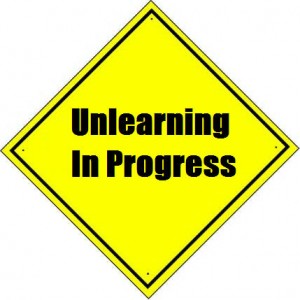 It’s been said that in today’s chaotic markets, the only sustainable competitive advantage may be the ability to learn faster than your competitors.
It’s been said that in today’s chaotic markets, the only sustainable competitive advantage may be the ability to learn faster than your competitors.
I disagree.
The ability for leaders and managers to learn quickly is certainly a critical advantage. Especially in industries where new technologies and/or rapidly changing customer expectations can disrupt the status quo overnight. But the ability to learn quickly is not nearly as important as the ability to unlearn faster than your competitors. The market leaders of the future will be those companies that not only learn quickly, but can shed outdated ideas and ways of thinking faster than their competitors.
Think of it like a dusty old attic, full of stuff that had some intrinsic value at one point in time, but now does little more than gather cobwebs. If we want to put anything new in the attic, we first have to get rid of some of the old stuff. In business, our brains operate the same way. If we want to embrace new ideas about how to add value to our customers, we must first get rid of old ideas and old ways of running our businesses. Not all of them, mind you; just the ones that are no longer working or should have been updated.
How do we know which ideas to keep and which to relegate to the discard pile? Therein lies the problem.
Often, old ideas that are no longer working are the same ones that contributed the most to our current success. Because of their success, these ideas became a fundamental part of our basic assumptions regarding what we know to be true about our customers, our markets, and our industry. Over time, they changed from assumptions to “facts.” Eventually they became so ingrained in our thinking that to question these “facts” is considered heresy. But even for those who dare to challenge these “sacred cows,” it seems counterintuitive to throw out what has worked so well for an extended period of time.
The solution lies in taking a regular assumption inventory in order to separate the old from the new, the good from the bad, and the still working from the everything changed, so have to update ones.
Companies do this all the time with physical inventories. Once or twice a year we go through everything that’s sitting on the shelves, take stock of what we have, and get rid of outdated or obsolete products by marking them down or writing them off. This clears the way for new products that can be sold for a higher price or better profit margin (hopefully).
I’m suggesting we do the same with our ideas and assumptions. Only we need to do it more often than once or twice a year. Considering the speed at which the world moves, things we knew to be true as little as six months ago may no longer be valid. And the sooner we find that out, the better. So I recommend an assumption inventory at least once a quarter, and even monthly for industries undergoing profound change.
What does an assumption inventory look like? Gather your management team and ask questions like:
- What has changed with our customers, our markets, our industry and the world at large since our last inventory?
- What assumptions are we continuing to make simply because we “know them to be true?” Of these, which are no longer valid? How do we know that?
- What processes, systems, and ways of behaving are we continuing to hold onto because “we have always done it that way?”
- What ideas for new products or services have we come up with recently but didn’t follow through because “that will never work”? What has changed that might now make them feasible?
The key is to make our thinking as transparent as possible. As humans and as organizations, we tend to be very invested in what we know to be true. We unconsciously seek to prove what we think is right, and as a result we miss critical data that might indicate the time has come to discard our outdated viewpoints. To unlearn, we must constantly challenge what we know to be true, and then open our thinking to new and different possibilities.
Taking assumption inventories on a regular basis will go a long way toward building a sustainable competitive advantage for your organization. Isn’t it about time you started doing some unlearning?






